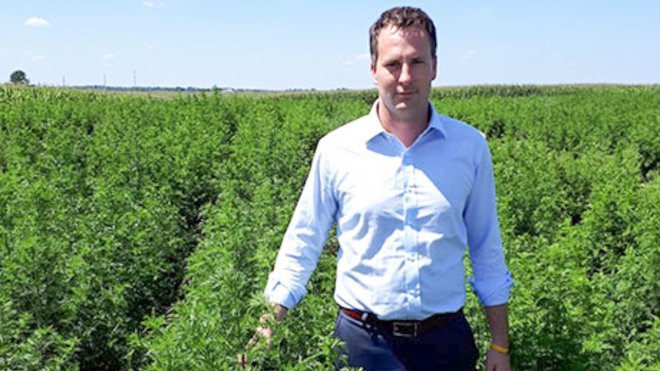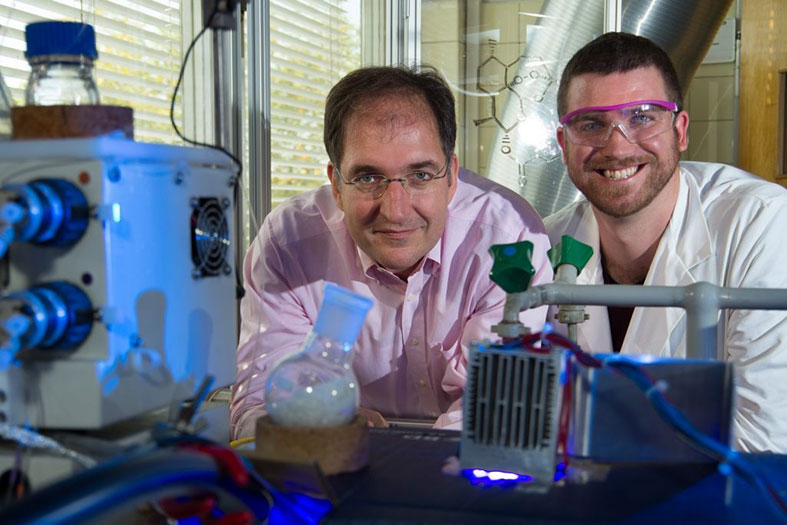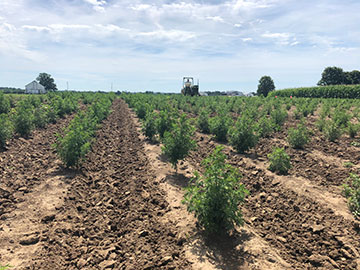RWU Alumni Launch a New Way to Wage the Fight Against Malaria
With a new method to make antimalarial medication and a plan to bring production into a single facility, their company hopes to meet one-third of global demand for medicine within three years

LEXINGTON, K.Y. – For two Roger Williams University alumni, seeing the first thriving crops of the sweet wormwood plant in the fields of Kentucky represent seeds of hope that their company’s new method of producing antimalarial medicine will revolutionize the fight against malaria.
Malaria continues to be a global health crisis, killing nearly 500,000 people a year with two-thirds of those deaths in children under the age of 5, according to the World Health Organization. Millions are infected each year, primarily in Africa and Asia, but the disease is highly treatable and can be cured with medicines such as artemisinin-based combination therapies. The problem is that not enough of the medicine is produced to meet the global demand.
Kerry Gilmore ’06, along with his fellow researcher Peter Seeberger, recently developed a groundbreaking method to produce twice the amount of high-quality artemisinin from each sweet wormwood plant (Artemisia annua), the main ingredient in the gold-standard treatment for malaria. With their patented chemistry breakthrough, they plan to also break ground on a new way of producing the antimalarial medicine and bringing it to market with their company ArtemiFlow USA. In January, they hired Gilmore’s good friend and fellow Hawk Adam Maust ’05 as corporate executive officer to establish the company in the United States.
“There are only two ways to fix the problem: inject more money into the system and buy more medicine that is out there, or produce these medications more cheaply and efficiently – and that’s what we’re going to do on a larger scale,” said Gilmore, who holds bachelor degrees in chemistry and biology from RWU and a doctorate in organic chemistry from Florida State University.
Because the plant is mostly grown on small farms in Vietnam and China, Gilmore says the current process goes through several middlemen before it gets to the market, contributing to higher costs for those who need it and the prevalence of scammers selling fake malaria medicine on the black market. That’s why their plan is to consolidate production of antimalarial medicine, from farming to extraction and creating the pharmaceutical, into a single facility.
To test whether artemisinin would grow on United States soil, ArtemiFlow partnered with the University of Kentucky to conduct a field study and successfully yielded a first crop late last year. With that favorable outcome, they are now moving forward with finding a location to build a facility in the region.
“The intention is that from plant to pill, all can be done in one place now, which drastically reduces the cost of making the medicine,” said Maust, who holds a bachelor degree in political science from RWU. “And with us being able to extract more medicine out of the plant at the highest (FDA) standard, we will be able to exceed the amount of medicine the World Health Organization needs to fight malaria.”

Over the past six years, Gilmore and Seeberger worked together in Germany’s Max Planck Institute of Colloids and Interfaces to refine their technique for extracting artemisinin, enabling them to derive it from the plant as well as from the plant waste created during production. Their new method generates twice the volume of artemisinin than any previous technique, and it’s a more efficient and low-cost production.
“We’ve streamlined the chemistry side of things with our extraction process, so what we’re able to do now is produce the medication cheaper than anyone else in the world because we will have the entire supply chain in one place and we can do everything more efficiently,” Gilmore said. “It will allow us to truly industrialize how this medicine is produced and have an impact on the people who need this medication. There’s no reason anyone should die from this disease. We just need more medication.”
The RWU Connection
They had a vision and groundbreaking science, but their mission wouldn’t have left the ground without Maust and Gilmore’s connection to RWU and to each other.
Both say their hands-on educational experiences and multiple opportunities to conduct research prepared them well for successful careers – Maust as political director of the Pennsylvania House Republican Campaign Committee and partner at Red Maverick Media, and Gilmore as a Fulbright Scholar, chemist and assistant professor at the Max Planck Institute of Colloids and Interfaces.
Maust credited RWU with giving him “the tools to be very successful at a young age,” from classes that developed his critical thinking and foundational skills for a career in politics to getting his first taste of working on campaigns. Gilmore said the opportunity to conduct undergraduate research both in chemistry and biotechnology, as well as present research at national conferences and make connections to eminent scientists, helped launch his path into graduate school and to work at a prestigious research institute.
But they didn’t have any of the same classes and their professional paths might have never crossed, if they hadn’t met and become best friends at Roger Williams, playing on the ultimate Frisbee club, acting in comedy skits at the Barn, and working a summer together as Orientation Advisers. They’ve remained close since graduation, traveling to see each other around the world and often talking about their work.

One day while Maust was visiting in Germany, Gilmore and Seeberger were discussing where in the world the wormwood plant could grow beyond Southeast Asia. Maust looked at their topographical maps and suggested Kentucky, knowing the terrain well from his career focused on political work in that region.
At the time, Maust was working at Red Maverick Media and managing hundreds of state and federal political campaigns throughout Kentucky, Pennsylvania, West Virginia and Ohio. His specialty was running caucuses, helping large campaign committees run races throughout their state. Maust made some calls to members of the Kentucky House of Representatives and connected ArtemiFlow with the University of Kentucky to begin field studies on the sweet wormwood plant.
“They’d developed this wonderful patented technology, but not having the connections to easily call and get a voice in these offices I think is a gap that always exists between these worlds and often why a lot of projects probably don’t get off the ground,” Maust said.
When the first field study yielded superior results, Gilmore and Seeberger knew they had a viable venture and asked Maust to come on board as CEO in January.
“When we traveled to Kentucky for meetings and started to see this take shape, we realized this was going to grow past the point of a couple of academics in a lab and that the wonderful impact we dreamed of was going to become a reality,” Gilmore said. “When we brought Adam in, he brought an extra perspective and a kick of energy, along with the vision and his connections to bring people together, to drive this forward.”
“Maust has proven to have the experience, ingenuity, and the relationships needed to lead ArtemiFlow from the development stage into production at a massive scale,” Seeberger said.
Growing Seeds of Hope
Their goal is ambitious: to meet one-third of the global demand for malaria medicine with their first batch, and to continue to increase production from there.
What’s more, Gilmore says that artemisinin has been showing great promise in treating cancers, including breast cancer, cervical cancer, and colorectal cancer, in pre-clinical trials. He says those studies have shown that artemisinin fights these cancers without producing painful side effects of chemotherapy, and it can eradicate cancer if it’s caught early enough. Recognizing that potential, ArtemiFlow is partnering with the University of Kentucky’s Markey Cancer Center to explore artemisinin’s potential to cure cancer in human trials starting this year.
As his first objective as CEO, Maust is identifying where to locate the company – looking at where the company will have the most political support and local agricultural knowledge. He’s continuing to meet with farmers who will grow the wormwood plants, in many cases in place of tobacco crops. It turns out that wormwood “grows in a similar pattern of time as development as tobacco, which is what cued me up to look at the states I’m familiar with,” Maust said.
It’s ironic, Maust added, that farmers who once grew a known cancer agent could wind up instead growing a cure for cancer. But he says that it’s just part of the amazing story that ArtemiFlow will bring to life.
“The wild thing about this is that a political science guy who is best friends with a scientist in Germany can connect with a farmer in Kentucky to create a product that will save not only hundreds of thousands of lives in Africa, but potentially millions more over its course with malaria and the potential for cancer,” Maust said. “We have the opportunity to really put a mark on this world and the great part is that there’s so many opportunities for people to put a mark on this themselves.”
That seed of hope they grew with the first wormwood crops might yet yield the fruit of their dreams and become a serious agent in the fight against malaria and cancer.